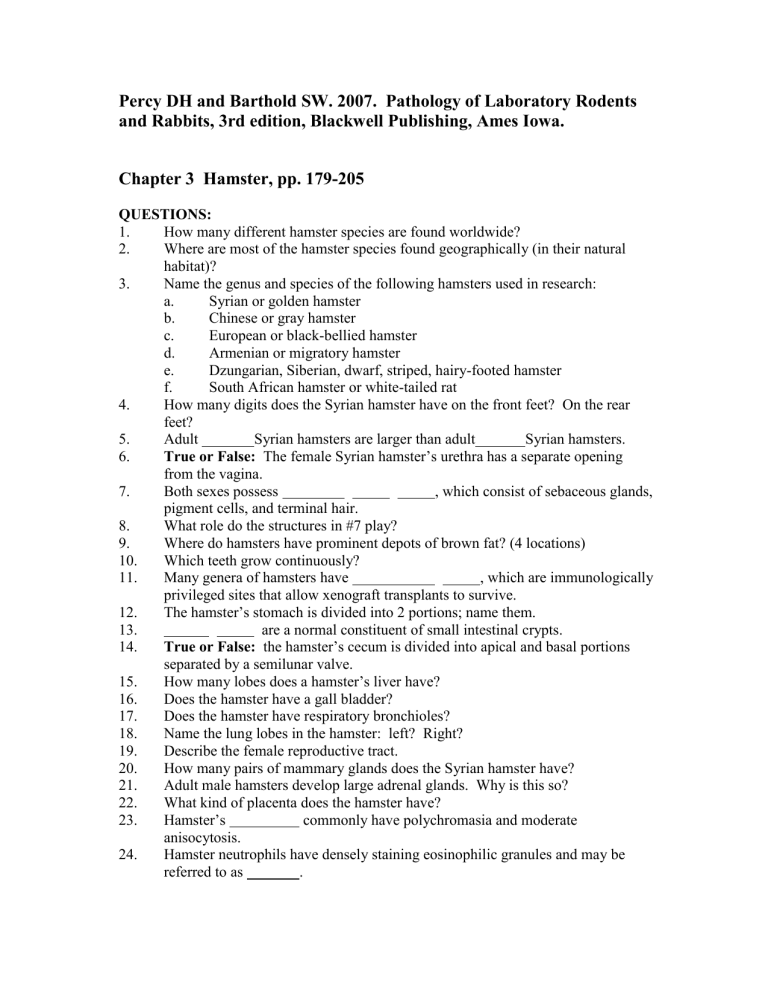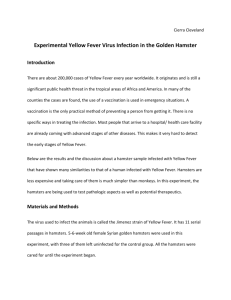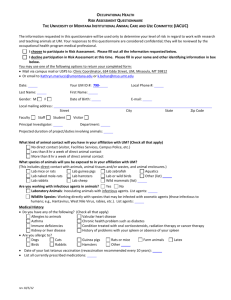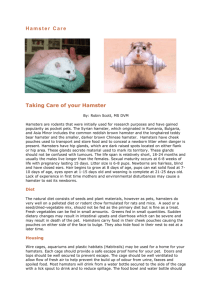Hamster

Percy DH and Barthold SW. 2007. Pathology of Laboratory Rodents and Rabbits, 3rd edition, Blackwell Publishing, Ames Iowa.
Chapter 3 Hamster, pp. 179-205
QUESTIONS:
1.
2.
How many different hamster species are found worldwide?
Where are most of the hamster species found geographically (in their natural
3. habitat)?
Name the genus and species of the following hamsters used in research: a. Syrian or golden hamster b. c.
Chinese or gray hamster
European or black-bellied hamster d. e. f.
Armenian or migratory hamster
Dzungarian, Siberian, dwarf, striped, hairy-footed hamster
South African hamster or white-tailed rat
4. How many digits does the Syrian hamster have on the front feet? On the rear feet?
Adult Syrian hamsters are larger than adult Syrian hamsters. 5.
6. True or False: The female Syrian hamster’s urethra has a separate opening from the vagina.
Both sexes possess , which consist of sebaceous glands, 7.
8.
9. pigment cells, and terminal hair.
What role do the structures in #7 play?
Where do hamsters have prominent depots of brown fat? (4 locations)
10. Which teeth grow continuously?
11. Many genera of hamsters have , which are immunologically privileged sites that allow xenograft transplants to survive.
12.
The hamster’s stomach is divided into 2 portions; name them.
13. are a normal constituent of small intestinal crypts.
14. True or False: the hamster’s cecum is divided into apical and basal portions separated by a semilunar valve.
15.
How many lobes does a hamster’s liver have?
16. Does the hamster have a gall bladder?
17. Does the hamster have respiratory bronchioles?
18. Name the lung lobes in the hamster: left? Right?
19. Describe the female reproductive tract.
20. How many pairs of mammary glands does the Syrian hamster have?
21. Adult male hamsters develop large adrenal glands. Why is this so?
22. What kind of placenta does the hamster have?
23. Hamster’s commonly have polychromasia and moderate anisocytosis.
24. Hamster neutrophils have densely staining eosinophilic granules and may be referred to as .
25. True or False: Antibodies to the MAdV-2 (K87) strain of mouse adenovirus are commonly present in hamsters from commercial suppliers in the US.
26. True or False: Adenovirus commonly causes clinical signs in hamsters.
27. Name the pathologic hallmark of adenoviral infection in the hamster.
28. Malformed or missing incisors in suckling and weanling hamster pups is indicative of what?
29. Hamsters infected with Hamster Parvovirus have which of the following lesions: a. Enamel hypoplasia of the incisor teeth b. c. d.
Periodontitis
Multifocal cerebral mineralization
Testicular atrophy with multifocal necrosis and mineralization of cells e. lining seminiferous tubules
All of the above
30. True or False: Hamster parvovirus is over 98% homologous to MPV-3.
31. Name the cause of transmissible lymphoma in hamsters.
32. Keratinizing skin tumors of hair follicle origin are caused by what virus?
33. HaPV is spread by environmental contamination with infected
34. True or False: HaPV is oncogenic, but tumor formation is a side effect of
. infection and not critical to the virus life cycle.
35. Do lymphomas caused by HaPV have detectable infectious virus?
36. True or False: HaPV epitheliomas have virus replication in keratinizing epithelium, similar to the behavior of papillomaviruses.
37. Explain what may happen when HaPV is introduced into a naïve population of breeding hamsters.
38. Hamsters with lymphoma appear thin and often have palpable masses in their abdomens. Where do lymphomas usually arise?
39. Why is epizootic HaPV unmistakable?
40. True or False: Trichoepitheliomas have been described in hamsters due to causes other than HaPV.
41. Describe how to effectively eliminate HaPV.
42. Lymphocytic choriomeningitis (LCM) virus is an with a wide host range, including humans, rodents, and NHP. Its principal natural reservoir host is the .
43. Infection with LCMV may occur by exposure to: a. Urine b. c. d.
Saliva
Feces a and b e. b and c
44. The patterns of disease that occur in hamsters post-exposure depend on: a. Age of the animal b. c. d.
45.
Strain and dose of the virus
Route of inoculation
All of the above
is the recognized method for confirming the diagnosis of LCM.
46. LCMV-infected hamsters are recognized to be a source of infection in human patients.
47. True or False: Pneumonia Virus of Mice (PVM) can cause infections in hamsters that normally go unrecognized as a subclinical event.
48. The significance of PVM infection in hamsters is unknown; however, it could represent a complicating factor in research.
49. True or False: Sendai virus causes clinical disease in hamsters characterized by respiratory dysfunction.
50. Describe the histopathologic changes caused by Sendai virus in the hamster.
51. True or False: Campylobacter jejuni has been isolated from hamsters with enteritis but not from clinically normal hamsters.
52. Name 8 antibiotics that have been associated with enterocolitis in hamsters.
53. The predominant bacterial flora in the hamster intestine are and
.
54. After therapy with narrow-spectrum antibiotics, there can be overgrowth of
, resulting in acute colitis, diarrhea, and death.
55. Oral administration of from normal animals following vancomycin treatment provides protection to most hamsters.
56. True or False: Acute enteritis with mortality has been associated with C. difficile infection in hamsters with no previous history of antibiotic therapy.
57. Microscopically, with mucosal damage is the characteristic finding
(C. difficile).
58. Spontaneous cases of cecal hyperplasia have been observed in: a. b.
Suckling hamsters
Weanling hamsters c. d. e.
Adult hamsters a and b b and c
59. Name 3 clinical signs associated with cecal hyperplasia?
60. What is the causative agent of cecal hyperplasia?
61.
What is the cause of Tyzzer’s disease in hamsters?
62.
What age of hamster is most frequently affected with Tyzzer’s?
63. Which of the following lesions are seen in hamsters affected with Tyzzer’s disease? a. b. c. d.
Multifocal hepatic necrosis
Edematous and dilated ileum, cecum, colon
Focal granulomatous myocarditis a and b e. all of the above
64. Name the stain(s) used to demonstrate the Tyzzer’s organism in affected cells.
65. Enteropathogenic strains of E. coli may cause enteritis in what age of hamster?
66. Name some gross necropsy findings in cases of E. coli enteritis.
67. Proliferative ileitis (aka regional ileitis, hamster enteritis, terminal enteritis, atypical ileal hyperplasia, enzootic intestinal adenocarcinoma, proliferative bowel disease, wet tail) in the hamster is caused by:
68. Hamsters are normally resistant to proliferative ileitis by what age?
69. Describe the typical appearance of hamsters affected with proliferative ileitis.
70. Describe the gross appearance of the intestine in a hamster with proliferative ileitis.
71. How does one confirm the diagnosis of proliferative ileitis?
72. Which of the following Helicobacter species have been isolated in hamsters? a. H. mesocricetorum b. c.
H. cinaedi
H. aurati d. e.
H. cholecystis all of the above
73. H. aurati is a urease-positive bacterium that has been associated with naturally infected hamsters.
74. In hamsters, Salmonella serotypes frequent isolates.
and are the most in
75. Name typical clinical signs seen during explosive outbreaks of Salmonellosis.
76. Name typical gross necropsy findings in Salmonellosis.
77. Name typical microscopic findings in Salmonellosis.
78. True or False: Salmonellosis is a common disease in hamsters around the world.
79. True or False: The hamster serves as a host for Corynebacterium kutscheri but is relatively resistant to clinical disease.
80. Hamsters may be infested with which of the following mites: a. Notoedres notoedres b. c.
Demodex criceti
Ornithonyssus bacoti d. e.
Demodex aurati
All of the above
81. True or False: In hamsters with demodicosis, denuded areas of skin are typically pruritic, dry, and scaling.
82. Specimens for diagnosis of mites should be obtained from which sex of hamster?
83. True or False: Hamsters are host to many enteric protozoa, but very few protozoa have any pathogenic significance.
84. True or Fals e: Spironucleus muris is commonly found in hamsters but the significance of the infection in Syrian hamsters is yet to be determined.
85. Giardia muris causes which of the following in hamsters: a. no clinical signs b. chronic emaciation and diarrhea c. enterotyphlocolitis d. e. all of the above none of the above
86. Describe how to diagnosis Giardiasis in the hamster.
87. Hamsters may be infected with which of the following pinworms? a. Syphacia criceti b. c. d.
Syphacia mesocriceti
Syphacia obvelata
S. muris
e. a and b
88. f. all of the above
Liver cysts of , the intermediate stage of Taenia taeniaformis, a tapeworm of dogs and cats, have been found in hamsters.
89. Spontaneous hemorrhagic necrosis (SHN) has been recognized in what age of hamsters?
90. Which of the following is true regarding SHN? a. SHN-affected hamsters are stillborn or weak at birth and are frequently b. cannibalized by the dam
Symmetrical subependymal vascular degeneration with edema and hemorrhage in the adjacent neuropil is seen in the prosencephalon c. d. e.
There are strain-related variations in susceptibility to disease
Diets deficient in available Vitamin E cause SHN all of the above
91. Diabetes mellitus is a genetically recessive disorder in occurring with high incidence in some inbred lines.
hamsters,
92. Which of the following environmental/genetic disorders have been identified in hamsters? a. b. c. bedding-associated dermatitis malocclusion hydrocephalus d. e. periodontal disease all of the above
93. True or False: Stress may cause females to become pugilistic or cannibalistic.
94. Name the common diseases associated with aging in hamsters.
95. Match the correct age-related disease with the pathologic description: a. affected kidneys are pale and granular in appearance, with irregular cortical depressions b. c. severe dyspnea secondary to CHF; thrombus in left auricle/atrium pale kidneys with irregular granular subcapsular surface; swollen liver with prominent lobular pattern d. e. uniform nodularity to hepatic capsular surface raised cystic areas of variable size, up to 2 cm diameter, present on the capsule and within the parenchyma of the liver
96. True or False : Spontaneous lymphomas (not associated with hamster polyoma virus) and cutaneous lymphoma resembling mycosis fungoides have both been identified in adult hamsters.
ANSWERS:
1. 25
2.
3. southeastern Europe and Asia a. b.
Mesocricetus auratus
Cricetulus griseus c. d. e.
Cricetus cricetus
Cricetulus migratorius
Phodopus sungorus
4.
5.
6. f. Mystromys albicaudatus
4 and 5 female; male
True
7.
8. paired flank organs conversion of testosterone to dihydrotestosterone
9. beneath/between scapulae; axilla; neck; between adrenals and kidneys
10. incisors (not molars)
11. buccal pouches
12. nonglandular and glandular segments
13. Paneth cells
14. True
15. 4
16. Yes
17. No
18. Single left lobe; right cranial, middle, caudal, intermediate, and accessory
19. Duplex uterus with 2 cervical canals that merge into a single external cervical os
20. 7 pairs
21. Zona reticularis enlarges to 3x the size of the female
22. labyrinthine hemochorial
23. erythrocytes
24. heterophils
25. True
26. False; infected hamsters are asymptomatic
27. Large, amphophilic intranuclear inclusions in enterocytes lining villi and goblet cells of jejunum & ileum
28. Toolan H-1 virus (rat parvovirus)
29. E
30. True. Infection in hamsters occurs through interspecies transmission from mice, which are the natural rodent host for this virus.
31. Hamster polyoma virus (HaPV); transmissible lymphoma can occur in epizootics among young hamsters
32. HaPV; not to be called hamster papillomavirus even though the polyoma virus can cause papilloma-like skin lesions
33. Urine
34. True
35. No. This is because HaPV can infect cells lytically with virus replication or transform cells without virus replication.
36. True
37. Epizootic of lymphoma, with attack rates as high as 80% among young hamsters within 4-30 wk postexposure (this is a diagnostic phenomenon). Infected hamsters may also have epitheliomas, usually around the face and feet. Once enzootic, incidence of lymphoma declines to much lower levels.
38. In the mesentery, without involvement of the spleen. Can also occur in axillary and cervical l.n. Infiltration of liver, kidney, thymus, other organs may occur.
39. Lymphoid tumors are otherwise rare in hamsters and when they occur it is in aged hamsters.
40. False
41. Total depopulation and thorough decontamination of the premises. The virus is resistant to environmental decontamination.
42. Arenavirus; wild mouse
43. D
44. D
45. Serology
46. Zoonotic
47. True
48. Pulmonary
49. False. Hamsters are often serologically positive for Sendai but typically show no clinical signs.
50. Focal to segmental rhinitis progressing to necrotizing tracheitis and multifocal bronchoalveolitis; typically resolve by 12 days post-inoculation.
51. False. It has been isolated from both, and subclinically infected hamsters may shed the organism in the faces for up to several months.
52. Lincomycin, clindamycin, ampicillin, vancomycin, erythromycin, cephalosporins, gentamicin, penicillin
53. Lactobacillus and Bacteroides
54. Clostridium difficile
55. Cecal contents
56. True
57. Necrotizing typhlitis
58. D
59. Runting, diarrhea, high mortality
60. None has been identified, it may be the recovery phase of clostridial enteropathy
61. Clostridium piliforme
62. Weanling
63. E
64. Warthin-Starry or Giemsa
65. Weanling
66. SI – yellow to dark red fluid; colitis, typhlitis +/- colonic intussusceptions
67. Lawsonia intracellularis
68. 10-12 wk of age
69. Runted, emaciated, soiling of the perineum with diarrhea
70. Ileum is segmentally thickened, often with prominent serosal nodules and fibrinous peritoneal adhesions to adjacent structures. Opened bowel has abrupt transition of craniad, normal ileum, and caudal cecum with the affected hyperplastic mucosa.
71. Demonstration of typical lesions is usually sufficient to confirm the diagnosis.
72. E
73. gastritis
74. typhimurium and enteriditis
75. depression, ruffled hair coat, anorexia, dyspnea, high mortality
76. Multifocal, pinpoint pale areas in the liver, patchy pulmonary hemorrhage and reddened hilar lymph nodes.
77. multifocal interstitial pneumonitis; pulmonary venous septic thrombophlebitis; focal splenic necrosis and focal necrotizing hepatitis
78. False; it is rare but when present can cause severe disease; zoonosis also
79. True
80. E
81. False. Denuded areas are usually NON-pruritic.
82. Male – they typically have a larger mite load than females.
83. True
84. True
85. D
86. Wet mount prep from duodenal region (pear shaped organisms tumbling); banded cyst forms in wet mount prep or Giemsa-stained prep; fecal flotation showing thick-walled ellipsoidal cysts containing 4 nuclei.
87. F
88. Cysticercus fasciolaris
89. fetal hamsters in the last trimester and newborn hamsters
90. E
91. Chinese
92. E
93. True
94. Hamster Glomerulonephropathy (arteriolar nephrosclerosis); Amyloidosis; Atrial
Thrombosis; Polycystic Liver Disease; Bile Ductular Hyperplasia/Hepatic
Cirrhosis
95. a. b. c. d. e.
96. True
Hamster Glomerulonephropathy
Atrial Thrombosis
Amyloidosis
Bile Ductular Hyperplasia
Polycystic Liver Disease









